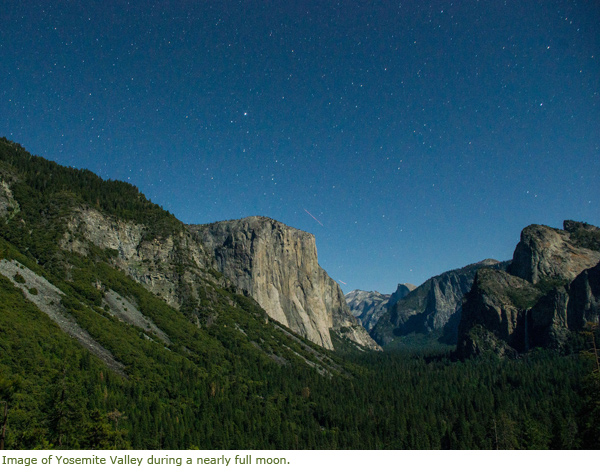
Imagine the sounds you would hear in urban areas…horns honking, motors revving, car alarms blaring…these sounds quickly add up to what could be an unhealthy accumulation of decibels. Will these sounds soon flood out Yosemite's natural sounds? Let's hope not! Solitude is a large part of the wilderness experience. The raw soundscape, a symphony of natural sounds resonating in the mountain¬¬s - birds chirping, leaves rustling from the wind, the thunderous waterfalls and raging rivers - are all a part of the allure of a national park. Some of my best Yosemite memories include hitting the trails at dawn, without another soul in sight, listening to the stir of the wildlife and water. A recent National Park Service (NPS) survey showed that 72% percent of visitors to national parks say that one of the most important reasons for preserving national parks is to provide opportunities to experience natural peace and the sounds of nature.
Now, think of Vegas for a moment! Neon lights blinking and flashing, designed to compete for our attention, 24/7! There is definitely a time for Vegas fun, but the Vegas experience is at the exact opposite end of the spectrum as the Yosemite experience! The Milky Way and the constellations with an occasional meteor shower are on the main stage and are what steals the show on a clear Yosemite summer night. I will never forget hiking Half Dome on a full moon night, peering into Tenaya Canyon as I ascended the cables and sat quietly at the top, mesmerized by what my eyes were seeing. I remember being startled by seeing the bright lights of the Central Valley, light pollution from Fresno, Merced and Modesto. Seeing a natural nightscape in Yosemite is a unique experience, however, seeing a natural nightscape in the United States is becoming a threatened experience. According to Yosemite's NPS website: "Currently, two-thirds of Americans cannot see the Milky Way from their backyard, and if current light pollution trends continue, there will be almost no dark skies left in the contiguous United States by 2025. Many people seek national parks to experience this vanishing resource."
Yosemite Valley, once described as a grand cathedral, and considered one of our nation's "crown jewels," displays a landscape like no other! The towering cliffs, bellowing waterfalls, colossal trees, and wildlife lure nearly 4 million people per year here. This Valley lured me here in 1999 because I wanted to experience the immensity of this place in person, and now it's considered a second home! I guess it's a no-brainer to state that this landscape needs to be in a constant state of protection. Could you imagine a tramway or cable car extending from the Valley to Half Dome or Glacier Point? Some may think this is a good idea, some may think this is a bad idea. I personally would want the beauty of Yosemite to be kept in its most natural state. Studies have shown that urban sprawl and overdevelopment are creeping into wilderness areas and soon enough people will have to go to their local national park to experience the wilderness.
So, in order for Yosemite's soundscapes, nightscapes and landscapes to remain "unimpaired for future generations," park managers do all they can to manage and protect Yosemite, but a large part of the responsibility also falls on our shoulders, Yosemite's employees, residents, and visitors.
Learn more about Yosemite's dark night skies and soundscapes.

